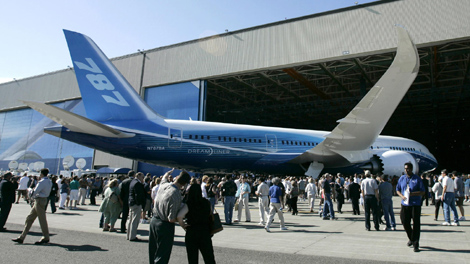Here is a summary of Boeing's effort to build the first passenger plane made from lightweight carbon composite parts rather than metal:
ORIGINS -- On Dec. 20, 2002, Boeing officially drops plans for the Sonic Cruiser, which would have traveled near the speed of sound, and on Jan. 29, 2003, the company establishes a leadership team for the 7E7, its first all-new airplane since the 777 in 1990. Composites are chosen as the primary material the next June.
STARTUP -- All Nippon Airways of Japan orders 50 of the planes, and Boeing's board of directors approves the launch of the 7E7 program on April 26, 2004. In January 2005 the model name is changed to the 787, and at the end of the year the first deliveries are set for early summer 2008.
PROBLEMS BEGIN-- Boeing reveals production snags on June 12, 2007, including a gap where the left side of the nose-and-cockpit section is out of alignment with the fuselage. Another problem is an industrywide shortage of fasteners that hold the plane together.
ROLL OUT - On July 7, 2007, Boeing rolls out the first 787 at the Everett, WA assembly plant.
FIRST DELAYS -- On Sept. 5, 2007, Boeing says the 787 will begin flight testing in mid-November or mid-December, months later than originally planned. On Oct. 10, 2007, Boeing delays first deliveries by six months.
PERSONNEL CHANGE -- Boeing announces on Oct. 16, 2007, that Michael B. Bair, vice president and general manager of the 787 program for the past three years, has been replaced by Patrick M. Shanahan, previously head of Boeing's missile defense systems in Wichita, Kan. Bair is named vice president of business strategy and marketing and, on Oct. 31, 2007, says some suppliers of major components for the 787 have fallen short of Boeing's expectations.
PROMISES, PROMISES -- On Dec. 11, 2007, Boeing Commercial Airplanes CEO Scott E. Carson says there will be no further delay in 787 development, but a three-month delay is announced on Jan. 16, 2008, and an additional six-month stall is announced on April 9, 2008, postponing the projected debut of commercial service to the third quarter of 2009 -- the third revision to the delivery schedule and the fourth change in plans for first test flight.
LABOR DISPUTE -- An eight-week strike by the Machinists union that began Sept. 6, 2008, and lingering production problems, including installation of improper fasteners, pushes the first test flight into the second quarter of 2009 and first deliveries into the first quarter of 2010 -- the fourth schedule shift, making the first 787 nearly two years late. The top issue in the strike is job security as union members maintain that if more of the key production had been in-house instead of by subcontractors, the 787 would have been completed before the walkout.
ANOTHER HANGUP -- On June 23, 2009, Boeing announces that flight tests will be delayed an undetermined number of weeks for the design and installation of reinforcements along the upper part of the place where the wings join the fuselage. Carson says deliveries also will be pushed back.
NEW WRINKLE-- On Aug. 14, Boeing says it discovered microscopic wrinkles in the 787's fuselage skin and is installing a patch consisting of additional layers of carbon composite material. The company says it had ordered Italian supplier Alenia Aeronautica to halt production of the fuselage sections on June 23. It says the glitch was unrelated to the other structural problem announced that day.
HEADING SOUTH - On Oct. 28, Boeing announces it will build a second 787 assembly line in Charleston, S.C. Move is seen as a major blow to Everett, Wash. where the first 787 line is located.
WHEELS ROLLING - On Dec. 12, Boeing completed high-speed taxi tests on the 787 Dreamliner.


